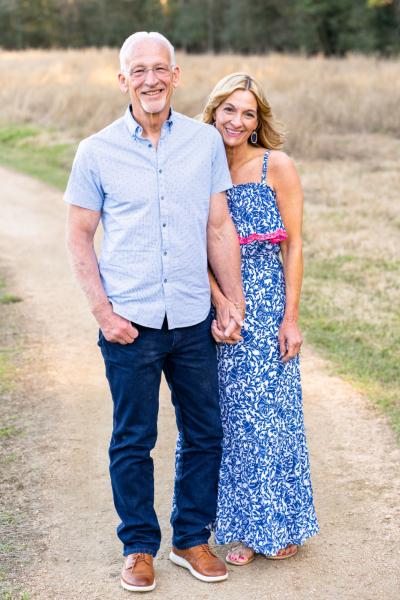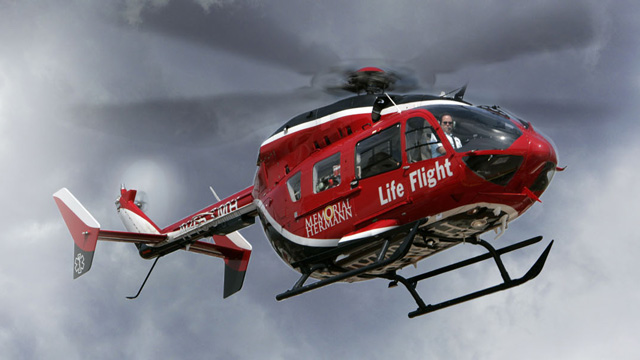
“The last thing I remember was walking my bike through the gate to the back,” he says. His wife, Michelle Eakin, who was in the couple’s home at the time of the incident, explains what happened next. “Through the window I saw Gary come up the driveway, and I heard the motorcycle rev up. Then I felt a bang. I looked out and saw a giant skid mark across the pool deck. I looked the other way and saw that Gary was pinned between the fence and his bike. He was knocked out. There was blood all over his head. I thought he was dead.”
Frantic, Michelle called 911 and ran next door to the home of the couple’s 33-year-old son, Gary, for help. But their son was unable to lift the bike off of his father. Neighbors arrived and began pulling boards off of the fence, finally freeing Gary from the wreckage. “It was so chaotic,” says Michelle.
EMS Arrives on Scene
Minutes later, paramedics from Kingwood Fire Department 101 arrived on the scene, stabilized Gary and transported him to nearby Kingwood Medical Center. Michelle says that Tests revealed several broken bones on the left side of his face and a brain bleed. Physicians were concerned his injuries might obstruct his airway.
Upon removing Gary’s clothes, however, the medical team’s priorities changed. In addition to burns on his right hand, wrist and lower leg, Gary had sustained severe burns on his buttocks and genitalia. It was apparent he needed to be placed in the care of a specialized burn unit. At about 2:30 the next morning, Gary was transported to the John S. Dunn Burn Center at the Red Duke Trauma Institute at Memorial Hermann-Texas Medical Center.
"Some of the worst burns I've ever seen."
Affiliated burn surgeon Todd Huzar, MD, FACS, associate professor of acute care surgery at McGovern Medical School at UTHealth Houston, was the first to treat Gary in the Burn Center. “We excised deep burns to his right hand and wrist and to his right lower extremity,” he says. “In addition, we further assessed burns to his genitalia and thighs. His were some of the worst burns I’ve seen, extending down to muscle in certain parts of his body.”
Over the next eight weeks, as an inpatient at the Burn Center, Gary underwent more than a dozen surgeries, including multiple debridement and skin grafting the medical team’s initial priority was procedures and a colostomy, performed by a team of surgeons that included Dr. Huzar, general surgeon John Harvin, MD, FACS, associate professor at UTHealth Houston, and plastic surgeon Daniel J. Freet, MD, FACS, associate professor at UTHealth Houston, and others.
As the family quickly learned, recovery from serious burn injury is not a straight line. “There were up days, down days, and twist and turn days,” says Michelle. “For the first few days, Gary was doing well, then he suddenly went downhill. Twice he was placed on a ventilator. We weren’t sure he was going to make it.”
Free Flap Procedure
Among the six surgeries Dr. Freet performed on Gary was the debridement and coverage of the wound of the dorsum (top side) of Gary’s right hand and forearm, which were so severely burned that at one point doctors thought they might need to amputate. During an eight-hour “free flap” procedure, Dr. Freet moved approximately 13 inches of tissue from Gary’s right leg to the top of his hand and wrist.
Michelle was at Gary’s side from the start, visiting him every day in the Burn Center. “The family was always there,” says Dr. Huzar, “which makes a big difference.” Michelle provided family and friends with daily Facebook updates and asked for their prayers.
Dr. Freet believes Gary’s positive attitude played a significant role in his recovery. “He has such a positive attitude about his injuries and his recovery and has always been extremely pleasant and easy to work with,” he says.
The Road Ahead
Gary’s prognosis is good, but his journey is not over. He continues to go to occupational therapy to increase the passive range of motion of his right hand, and he will undergo additional procedures to “debulk” (reduce the size of) the flap on his hand and wrist and to reverse his colostomy.
Gary says his motorcycle days are over. “I’ll never swing a leg over another bike,” he says. It was determined that a motorcycle malfunction triggered the accident. “The throttle was stuck wide open,” he says. It is believed that when his motorcycle struck the fence, his head hit the motorcycle’s speedometer, causing his head injuries. His burns were caused by the motorcycle’s exhaust system.
Strength in Faith
The family is extremely grateful for the care they’ve received—from the EMS personnel who cared for Gary on scene, to his surgeons, the nurses on the burn unit and his therapy team. “I want everyone at the hospital to know how grateful I am,” says Gary, his voice cracking. “They are the most amazing people.” Michelle adds, “I would mention each one by name—they deserve it—but there are so many.”
Throughout their ordeal, the couple has found strength in their faith. “I would never have chosen for this to happen,” says Gary. “But I feel privileged and honored to have been chosen to walk this road.”
“We have seen so many miracles,” says Michelle. “We see the hand of God all over this.”

Donate to Red Duke Trauma Institute
Please consider making a donation to the Red Duke Trauma Institute at Memorial Hermann-Texas Medical Center. No matter which area of the mission you support, your gift will make a lasting impact on patients and their families.
Donate NowRed Duke Trauma Institute Newsletter Sign Up
Use the form below to sign up to receive our Red Duke Trauma Institute Newsletter with helpful articles about our services, case studies relevant to clinical protocols practiced on a daily basis, information about available educational opportunities and many other updates for health care professionals and first responders.